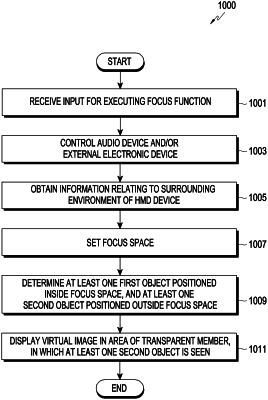| CPC G02B 27/0172 (2013.01) [G06T 11/00 (2013.01); G09G 3/002 (2013.01); H04R 1/028 (2013.01); G02B 2027/014 (2013.01); G02B 2027/0178 (2013.01); G06T 2207/20092 (2013.01); G09G 2354/00 (2013.01); H04R 2499/15 (2013.01)] | 14 Claims |

|
1. A head-mounted display (HMD) device comprising:
a transparent member;
a display;
at least one sensor; and
at least one processor functionally connected to the display and the at least one sensor,
wherein the at least one processor is configured to:
obtain information on a surrounding environment of the HMD device via the at least one sensor,
set a focus space generated based on a designated location,
based on the information on the surrounding environment and the focus space, determine at least one first object positioned inside the focus space, and at least one second object positioned outside the focus space, and
display, via the display, a virtual image in a first area of the transparent member, the at least one second object being seen in the first area, the virtual image having a size identical to a size of the first area such that the at least one second object is seen to be opaque or blurred and the at least one first object is seen to be transparent,
wherein the at least one processor is configured to:
set, as the focus space, a three-dimensional reality space determined based on a distance between a current location of the HMD device and a location of a designated object selected by a user input with respect to the current location of the HMD device, and
wherein the at least one first object, the at least one second object, and the designated object are real objects.
|